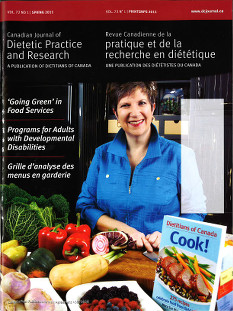Volume 72 • Number 1 • March 2011
Chair’s Message
Editor’s Message
Research
Purpose: Individuals with developmental disabilities have poor eating habits and are at increased risk for cardiovascular disease, obesity, and osteoporosis. Needs and preferences for a nutrition education and foods skills program were explored in adults with developmental disabilities, agency managers, and support workers. Methods: Twenty-eight adults with mild to moderate developmental disabilities participated in individual interviews; seven managers and 21 support workers took part in three focus group discussions. Concurrent data collection and analysis, data saturation, and a constant comparative method guided the research. Results: All participants indicated a need for nutrition education and cooking programs for this population. Seven major themes emerged: poor eating habits, safety concerns, low transferable skills, social relationships, staff training needs, resource needs, and limited funding. Individuals with developmental disabilities also expressed feelings of self-efficacy in learning to cook healthy food. Conclusions: There is a strong interest in and need for nutrition education and food skills programs for adults with developmental disabilities. The collaboration of multiple community partners in program implementation and delivery is essential. At the policy level, the needs of individuals with aging caregivers must be addressed and access to registered dietitians must be improved for this population.
Purpose: A process evaluation was conducted of the Northern Fruit and Vegetable Pilot Program (NFVPP), a government-funded health promotion initiative. The objectives were to determine how the program was implemented and to identify program facilitators and challenges. Methods: Facilitators and challenges in the implementation of the free fruit and vegetable snack program were assessed through qualitative interviews with school-level stakeholders (i.e., food preparers, teachers, and principals) and tracking wasted produce. The implementation of an enhanced nutrition education (ENE) component was assessed through a teacher survey. Results: School-level stakeholders saw the NFVPP as a valuable program. Key facilitators included teacher role-modelling and sufficient funding for supplies and personnel. Key challenges included produce delivery, quality, wastage, and variety. The ENE component was minimally implemented. Conclusions: The study identified program strengths and areas that could be improved. As a result, changes were made to how the NFVPP was implemented in schools the following year. The use of qualitative methods enabled program planners to understand the program implementation process.
Purpose: Nutrition and lifestyle habits in early childhood may be key to supporting healthy growth. The Nutrition Screening Tool for Every Preschooler (NutriSTEP®), a validated screening questionnaire for preschool nutrition risk, was implemented in two community health centres. Study objectives were to identify the proportion of children at nutrition risk and to assess acceptance and impact of dietitian referrals. Methods: Parents attending preschool immunization clinics were asked to complete a consent form, NutriSTEP®, and a parent questionnaire to gather demographics and perceptions of NutriSTEP®. Follow-up counselling by a dietitian was offered for parents of high-risk children, and parents who attended completed a follow-up questionnaire. Results: Seven percent of the children screened were at high risk. Almost 50% of parents reported adverse feeding environment behaviours. When a parent's reported daily frequency of a child's consumption was used as a proxy for daily servings, the majority of children fell short in most food groups. Thirty-three percent of 30 parents of high-risk children completed dietitian counselling. Most parents (75%, n=6) who were counselled reported making changes as a result of counselling and were satisfied with the service (63%). Conclusions: NutriSTEP® was an effective tool for identifying preschool children at risk. Although few parents accepted referral to a pediatric dietitian, most who did made changes to improve nutrition and lifestyle risk factors.
Perspectives in Practice
Une recension des écrits révèle l'absence d'outil servant à analyser la qualité des menus offerts en services de garde. Une grille d'analyse a été élaborée à cet effet, laquelle cible particulièrement l'offre alimentaire faite aux enfants d’âge préscolaire de plus de 18 mois. Cette grille a été développée à partir de la littérature scientifique récente. La version définitive de la grille d'analyse comprend 25 énoncés abordant: les types de menus, les groupes et recommandations du Guide alimentaire canadien, les sources de protéines, l'offre de boissons, les mets transformés, les produits cariogènes, la variété alimentaire, les allergènes et les propriétés organoleptiques des aliments. Les données recueillies à l'aide de cette grille serviront à l’élaboration de recommandations à formuler aux directions et aux responsables de cuisine des services de garde relativement à plusieurs composantes importantes dans la promotion de saines habitudes alimentaires à la petite enfance. Les limites de son utilisation sont associées à la nécessité de compléter les recommandations par l'analyse des recettes et ingrédients utilisés, des boissons offertes et de la taille des portions.
Primary health care aims to provide timely treatment of serious illness, teach health promotion, and maintain health for patients with chronic diseases. In partnership with the primary care network at Vancouver Coastal Health (VCH), family physicians (FPs), and dietitians, this practice needs assessment was undertaken to explore how VCH could support access to primary care nutrition services. Both qualitative and quantitative approaches were used. Data from two focus groups, one for dietitians and the other for physicians, were compiled and formed the questions for the survey. The data were analyzed using the inductive approach, to consider the messages or themes that appeared from the focus groups and the survey. A review of information from the focus groups, surveys, and literature revealed four common themes of findings: accessibility, collaboration in chronic disease management, health promotion, and information sharing. Sixty-six percent of FPs perceived that primary health nutrition services were fair to poor. Both dietitian and physician groups recognized that collaboration in the areas of chronic diseases and health promotion was essential, and that sharing of information among providers could improve this service.
Review
The process of professionalization has been widely studied in nursing, but little is known about it in dietetics. We explored the process of professionalization using an integrative review of nursing literature. Three research questions were addressed: 1. What are the stages of professional socialization? 2. Who are the participants in the socialization process? 3. What challenges are associated with the socialization process? From an initial list of 322 articles compiled from a search of relevant databases, 49 English-language primary research papers were selected for review. A form of constant comparative analysis was conducted to extract relevant data into categories based on the research questions. Findings suggest that the process of professional socialization is a complex and stressful process, which occurs in three phases and begins before entry into the formal education system. Within the formal education system, faculty and preceptors can have a positive or negative impact on an individual's professional growth and development. Much work is needed to develop an understanding of this process in dietetics, but the findings will have immediate relevance to dietitians’ educational and practice contexts.
Sustainability and the environment are issues influencing individual and organizational choices on purchasing, waste management, and energy-saving practices. The food service industry and related stakeholders have reported active pursuit of initiatives to reduce environmental impacts. We examine reported environmentally friendly practices being implemented in the food service industry and consider ways in which health care or hospital food services can adopt some of these programs. Building and equipment, waste management, food, and non-food supplies and procurement are considered. Suggestions are made for small changes to start the green initiative in each of these areas. A health care food service department is a large consumer of resources, and therefore food service workers, managers, dietitians, and administrators can make a significant difference by supporting and adopting environmentally friendly practices. Further studies are needed to determine which practices are currently being implemented in health care facilities in Canada, as well as perceived facilitators and barriers to these practices in the food service area.
North American family physicians and dietitians commonly recommend psyllium fibre supplementation for treating symptoms of irritable bowel syndrome (IBS). In this review, evidence on the effectiveness of psyllium supplementation for diagnosed IBS symptoms was evaluated and summarized. A systematic search of MEDLINE, CINAHL, and Web of Science was conducted. Included were full-length, peer-reviewed, English language articles in which psyllium ingestion was tested for its effect on IBS symptoms. Quality of these articles also was assessed. Twelve met the criteria for complete data abstraction. Seventy-five percent of the studies examined were of weak quality. Study designs and methods were heterogeneous. Patient-perceived global symptoms improved significantly in six of the nine studies measuring a global symptom outcome. In one study, significant improvements occurred in reported abdominal pain; in three, improvement did not occur. Quality of life and flatulence did not improve significantly in any studies in which these outcomes were examined. The results of this systematic review indicate limited and conflicting evidence to support the recommendation of psyllium supplementation for symptomatic IBS treatment.
Contemporary Western society emphasizes thinness for women, and the ideal female body size has become progressively smaller over the past half century. Meanwhile, the actual female body size has increased steadily, and rates of aberrant attitudes and behaviours surrounding food and weight have risen and tend to be much more common in overweight individuals. Thus disordered eating and excess body weight may perpetuate each other's development. We have synthesized the literature concerning female body size and disordered eating within a sociocultural context. Eight cognitions and behaviours that occur in women were examined: media exposure, weight stereotypes, body dissatisfaction, dieting, “fat talk,” emotional eating, perfectionism, and the “superwoman” ideal. The research literature suggests that these factors may play a role in both disordered eating and obesity. Furthermore, these factors may induce triggers, exacerbated by perfectionism and excess weight, that increase the risk of binge eating. These triggers include interpersonal discrepancies, low interpersonal esteem, depressive affect, and dietary restraint. Comprehensive interventions targeting the indicated sociocultural cognitions and behaviours, combined with healthy living education, may be the most effective strategy for reducing the prevalence of disordered eating and obesity among females.










